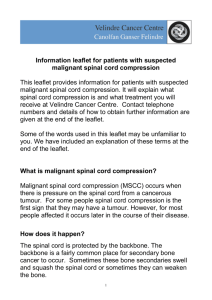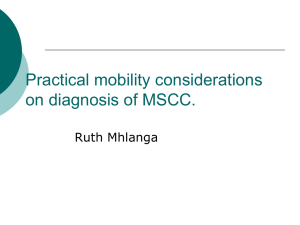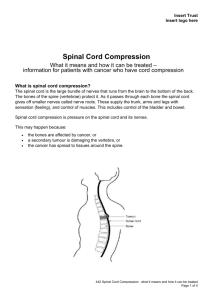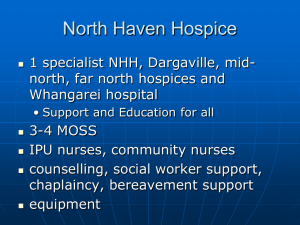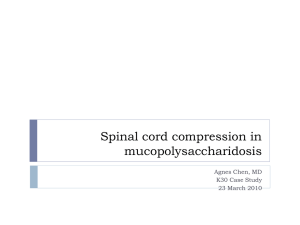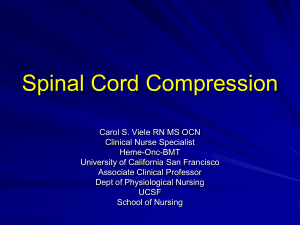Spinal cord compression
advertisement
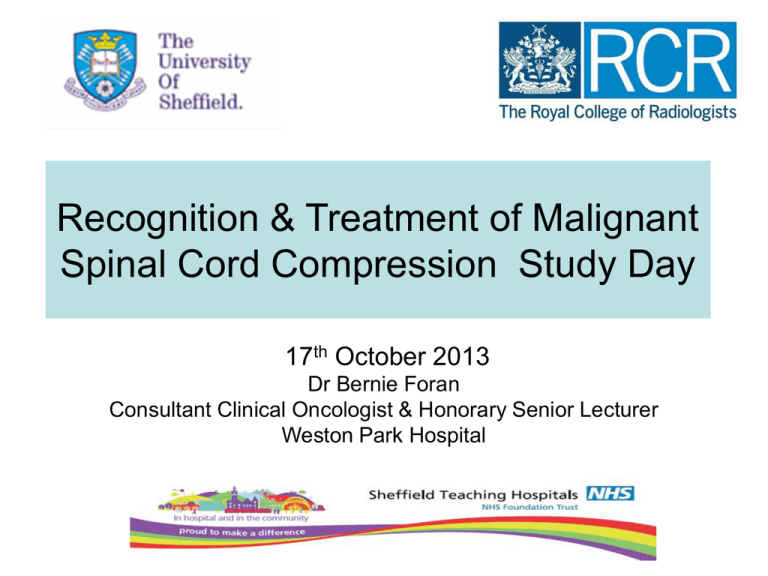
Recognition & Treatment of Malignant Spinal Cord Compression Study Day 17th October 2013 Dr Bernie Foran Consultant Clinical Oncologist & Honorary Senior Lecturer Weston Park Hospital Outline of Talk • Clinical case • The anatomy of the spinal cord • Definition of malignant spinal cord compression (MSCC) • Incidence • Symptoms & signs • Investigations • Treatments • Outcomes • NICE guidance Clinical Case 56 year old man with history of HTN & OA Presents to GP with 1 month history of back pain unresponsive to paracetamol Pain beginning to wake him at night More pain with lying down Shooting pains down right leg Examination • Observations - normal range • CVS, Resp, GI, GU exams - normal • Back exam – Inspection: normal – Palpation: some pain in L1 region – ROM: normal – Some pain in right leg with straight leg raising Lumbar Spine x-ray Age related degeneration Working diagnosis Sciatica V Back strain Treatment recommended NSAIDS Few days of bed rest 4 weeks later • Pain does not resolve • Various forms of pain control tried & fail • Wakes up, difficulty supporting his weight – subjective leg muscle weakness • Wife calls 999 • Taken to local A&E In A&E • Objective leg weakness on physical exam • A very keen medical student does a rectal exam and discovers a large nodular prostate • PSA: 45.0 • MRI Spine….. Anatomy of the spine Different spinal cord levels supply nerves for different regions of the body What is malignant spinal cord compression? • Occurs when cancer cells grow in/near to spine and press on the spinal cord & nerves • Results in swelling & reduction in the blood supply to the spinal cord & nerve roots • The symptoms are caused by the increasing pressure (compression) on the spinal cord & nerves Method of spread 85%From vertebral body or pedicle 10% Through intervertebral foramina (from paravertebral nodes or mass) 4% Intramedullary spread 1%(Low) Direct spread to epidural space Location Thoracic spine Lumbosacral spine Cervical spine 60% 30% 10% What types of cancer cause it? Most commonly seen in • • • • • Breast Lung Prostate Lymphoma Myeloma – 3-5% of patients with cancer overall – Approx 200 cases per annum in North Trent What are the signs & symptoms of MSCC? First Symptoms Pain Weakness Ataxia Sensory loss 95% 5% 1% 1% RED FLAGS….. First Red Flag: Pain • Usually first symptom – 80-90% of the time • Usually precedes other neurologic symptoms by 7 weeks – Increases in intensity • Severe local back pain • Aggravated by lying down – Distension of venous plexus Bach, F, Larsen, BH, Rohde, K, et al. Metastatic spinal cord compression. Occurrence, symptoms, clinical presentations and prognosis in 398 patients with spinal cord compression. Acta Neurochir (Wien) 1990; 107:37. Back pain – may be mild to begin with – lasts for more than 1 - 2 weeks • Pain may feel like a 'band' around the chest or abdomen (radicular) – Can radiate over the lower back, into the buttocks or legs Second Red Flag: Motor • Weakness: 60-85% – Tends to be symmetrical – Severity greatest with thoracic mets • At or above conus medularis – Extensors of the upper extremities • Above the thoracic spine – Weakness from corticospinal dysfunction – Affects flexors in the lower extremities • Patients may be hyper reflexic below the lesion and have extensor plantars Greenberg, HS, Kim, JH, Posner, JB. Epidural spinal cord compression from metastatic tumor: Results with a new treatment protocol. Ann Neurol 1980; 8:361. Third Red Flag: Sensory • Less common than motor findings • Still present in majority of cases • Ascending numbness and parathesias • Numbness or 'pins and needles' in toes & fingers or over the buttocks – Sensory level – Saddle anaesthesia • Feeling unsteady on feet, having difficulty with walking, or legs giving way Fourth Red Flag: Bladder & Bowel Function • Loss is late finding • Problems passing urine – may include difficulty controlling bladder function – passing very little urine – or passing none at all • Constipation or problems controlling bowels • Autonomic neuropathy presents usually as urinary retention – Rarely sole finding Duration of symptoms before diagnosis 2-5 months median It is an oncological emergency Requires very prompt diagnosis & treatment to try and prevent catastrophic consequences of paralysis & incontinence Investigations & information needed prior to Rx 1. MRI scan of the whole spine 2. 3. 4. Knowledge of cancer type & stage Knowledge of patient fitness Current neurological function 5. Can get compression at multiple levels Have they lost power in their legs? Can they walk? Do they need a catheter? Do they have pain? MRI of spinal cord compression in a women with past history of breast cancer Differential diagnosis • • • • • • • • Metastatic cancer Herniated disc Benign bony lesion Abscess Alcoholic neuropathy Primary tumour Osteoporosis Low potassium Case report 3/11 cases confirmed MSCC Treatment Until spinal stability is confirmed patients should be managed on bed rest BUT Wherever possible keep the patient moving Treatment Objectives • Pain control • Avoidance of complications • Preserve or improve neurological function Treatment options include: 1. Steroids & gastric protection 2. Analgesia 3. Surgery – decompression & stabilisation of the spine 4. Radiotherapy 5. Chemotherapy e.g. lymphoma 6. Hormonal manipulation e.g. prostate Ca WPH Reducing regimen for Spinal Cord Compression Day Dexamethasone daily dose Administration 1-3 16mg 16mg OM or 8mg BD (8am & 12noon) 4-6 8mg 8mg OM 7-9 4mg 4mg OM 10-12 2mg 2mg OM 13 Discontinue • While the patient is on steroids commence PPI (e.g. Lansoprazole) for gastric protection. • A slower reducing regimen may be required for patients who have received previous courses of steroids. Anticoagulation • Cancer is a hypercoaguable state • High burden of tumour in metastatic disease • Possible value in prophylaxis against venous thromboembolism • If patient not mobile – subcutaneous low molecular weight heparin +/- compression devices Constipation • Factors – Autonomic dysfunction – Limited mobility – Opiate analgesic • Risk of perforation – Masked by corticosteroids • Bowel regimen needed Surgery • RCT comparing surgery followed by RT vs. RT alone • Improvement in surgery + RT – Days remained ambulatory (126 vs. 35) – Percent that regained ambulation after therapy (56% vs. 19%) – Days remained continent (142 vs. 12) – Less steroid dose, less narcotics – Trend to increase survival Patchell, R, Tibbs, PA, Regine, WF, et al. A randomized trial of direct decompressive surgical resection in the treatment of spinal cord compression caused by metastasis (abstract). proc Am Soc Clin Oncol 2003; 22:1. Direct decompressive surgery • Relieves compression • Removes tumour • Stabilises spine But many patients not suitable • Unfit • Tumour factors Indications for Surgery • Unknown primary tumour • Relapse post RT • Progression while on RT • Intractable pain • Instability of spine • Patients with a single level of cord compression who have not been totally paraplegic for longer than 48 hours • Prognosis >4 months Radiotherapy • Urgent access 24/7 • Dose & schedule – Depending on neurological deficit, PS, previous treatment and cancer features • Single V fractionated treatment – SCORAD trial Radiotherapy Radiotherapy • Pre operatively – no • Post operatively – routinely • Definitive – all pts unsuitable for surgery – Unless • Total paraplegia (>24hrs) • Very poor prognosis Chemotherapy • Can be successful in chemosensitive tumours – Hodgkin’s lymphoma – Non-Hodgkin’s lymphoma – Neuroblastoma – Germ cell – Breast cancer (hormonal manipulation) – Prostate cancer (hormonal manipulation) Other considerations 1. Bed rest V mobilisation • • 2. 3. 4. 5. 6. Rehabilitation Braces & collars Psychological issues Urinary catheter Bowel function Nutrition Discharge issues Prognosis • Median survival with MSCC is 6 months • Ambulatory patients with radiosensitive tumours have the best prognosis – Likely to remain mobile Sorensen, PS, Borgesen, SE, Rohde, K, et al. Metastatic epidural spinal cord compression. Results of treatment and survival. Cancer 1990; 65:1502. MSCC is a poor prognostic indicator in cancer patients Need better detection rates Number of days survival following admission with spinal cord compression Data from WPH audit Number of days from admission with spinal cord compression to death Range = 2 days to 319 days Mean = 58.6 days Metastatic spinal cord compression Implementing NICE guidance 2008 NICE clinical guideline 75 Key priorities for implementation The areas identified as key priorities for implementation are: – Service configuration & urgency of treatment – Early detection – Imaging – Treatment of spinal metastases & MSCC – Supportive care & rehabilitation Early detection – Inform patients with cancer who are at risk of MSCC • information about the symptoms of MSCC • what to do & who to contact if symptoms develop – Discuss with the MSCC coordinator immediately patients with cancer who have symptoms of spinal metastases & neurological symptoms or signs suggestive of MSCC • view as an emergency. – Discuss with the MSCC coordinator within 24 hours patients with cancer who have symptoms suggestive of spinal metastases Bernadette.Foran@sth.nhs.uk

